Effective Solutions for Clogged Bathroom Tubs and Sinks
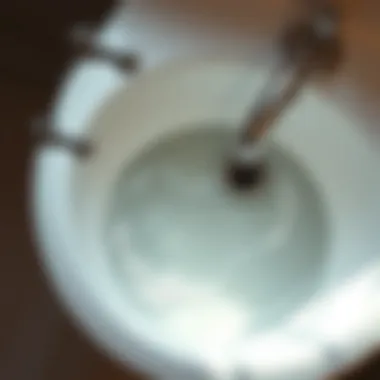
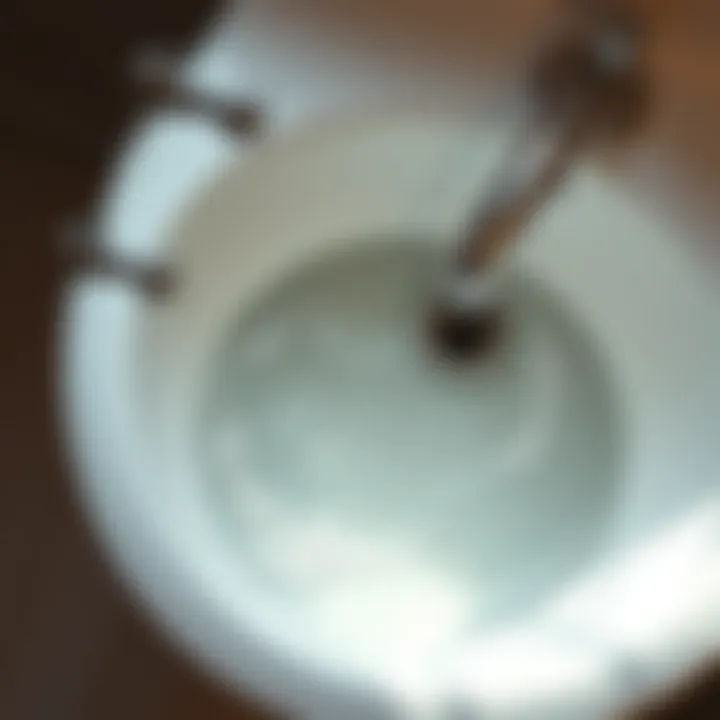
Intro
Dealing with a clogged bathroom tub or sink can feel like a never-ending nightmare. It’s one of those household headaches that can push even the most patient person to their limits. Bathing becomes a game of dodging splashes, and brushing teeth turns into a questionable adventure. Knowing how to address these pesky drainage issues can make all the difference in maintaining not just a functional bathroom but an inviting one as well.
Understanding the root causes of clogs, as well as preventive measures, can save homeowners a great deal of time, money, and frustration. In this article, we will dive into the common culprits behind clogs, offer some DIY solutions, and discuss when it might be wise to call in the big guns—plumbers who have it down to a science. Being ahead of the game can let you avoid the trap that is a sluggish drain.
Why It Matters
Tackling these drain woes is not just about addressing an overflow of water; it’s also about preserving the overall environment of your home. A linger odor or slow drain not only distracts from the aesthetics of your space but also signals that something deeper might be awry. Keeping your bathroom fresh is a reflection of good home maintenance, which is a crucial aspect of maintaining property value and comfort.
In the sections below, we will untangle the web of causes behind clogged sinks and tubs, share functional tips for prevention, and arm you with solid DIY fixes to tackle these issues head-on. With a little effort and knowledge, addressing drainage problems becomes less daunting, and more of a manageable chore.
Understanding Clogs in Bathroom Tubs and Sinks
When it comes to maintaining a pleasant home environment, addressing clogs in bathroom tubs and sinks should be high on the list. Understanding how these blockages develop equips homeowners with the knowledge to tackle them effectively. Clogs are not just a nuisance; they can lead to significant water damage, unpleasant odors, and increased water bills. Thus, recognizing the common causes and symptoms can save a homeowner time and money in the long run.
The Nature of Clogs
A clog forms when the normal flow of water is interrupted by materials that accumulate over time. This buildup can lead to slow drainage or, worse, a complete blockage. The importance of understanding the nature of clogs is paramount. By gaining insight into how clogs manifest, homeowners can take proactive steps to keep their plumbing systems in tip-top condition. Consider, for example, the lifecycle of a typical clog: from mere annoyance to a plumbing nightmare. The sooner one addresses these issues, the better the chances of avoiding a full-blown plumbing crisis.
Common Causes of Clogs
Hair Accumulation
Hair is one of the leading contributors to clogged drains, especially in bathrooms. Whether from daily showers or grooming routines, loose strands tend to weave together, forming stubborn clumps that catch other debris. The key characteristic of hair accumulation is its persistence; even a small amount can lead to significant problems over time. This aspect makes it a crucial focus in this discussion about clogs. The unique feature of hair is that it can trap other particles, such as dirt and soap scum, which further exacerbates the blockage. While removing hair clogs may seem manageable with regular cleaning, it often isn't enough. Homeowners need to be vigilant in their cleaning habits to prevent such accumulations.
Soap Scum Buildup
Another notable culprit is soap scum, a residue that forms when soap reacts with minerals found in tap water. This substance can cling to pipes and surfaces, slowly narrowing the passage where water flows. The key characteristic of soap scum buildup is its sticky nature, making it hard to remove and subsequently contributing to clogs. It's beneficial as a topic here because many homeowners might not realize how quickly soap scum can accumulate and what it can do to their plumbing. The unique feature of soap scum is that it often combines with organic materials, which can accelerate the clogging process. Therefore, tackling soap scum through routine cleaning is wise, as leaving it unchecked leads to dire consequences.
Foreign Objects
Foreign objects, ranging from small toys to cotton swabs, significantly contribute to drain blockages in bathroom sinks and tubs. The key characteristic of these items is their unexpected appearance in places they shouldn’t be. Such objects can create immediate blockages or worsen existing clogs. The unique feature of foreign objects is their variety; they can be anything that gets inadvertently swept down the drain. Their advantages are none, as they only serve to complicate the plumbing situation. To combat this issue, it’s imperative for homeowners to establish a habit of ensuring that only water and waste go down the drain.
Grease and Oils
Though we often associate grease and oils with kitchen drains, they can equally wreak havoc in bathrooms. These substances can solidify and cling to pipes, reducing their diameter and leading to clogs. The key characteristic of grease and oils is their chemical structure, which allows them to congeal at lower temperatures. It may not be obvious to homeowners, but these substances can accumulate over time, leading to serious drainage issues. Their unique feature is their tendency to trap other debris, much like hair or soap scum, which compounds the clogging issue. Thus, avoiding the disposal of greasy or oily products down the sink is crucial for maintaining clear drainage.
Identifying Symptoms of a Clog
Recognizing the symptoms of a clog in your bathroom tub or sink is essential for timely intervention. Ignoring these signs can lead to larger issues down the line, resulting in costly repairs or severe disruptions to your daily routine. Whether it's a bathtub that won't drain or a sink that backs up, identifying these issues early can often prevent a full-blown plumbing disaster. By familiarizing yourself with common symptoms, you can take immediate action, potentially saving both time and money.
Slow Drainage
One of the clearest indicators of a clog is slow drainage. Have you ever noticed that it takes longer for the water to disappear from your tub or sink? This is often the first sign that something is amiss. Slow drainage occurs when there's a partial blockage in the pipes, usually due to hair, soap scum, or other debris.
When you experience slow draining, it's important not to ignore it. Instead of brushing it off as a minor inconvenience, consider it a red flag waving in your face. Addressing slow drainage promptly can prevent a minor issue from morphing into a more significant problem. If left unchecked, it can escalate to a complete blockage, leading to standing water that is not just an eyesore, but a breeding ground for germs.
Unpleasant Odors
Unpleasant odors are another telltale sign that a clog may be forming. Ever walked into your bathroom only to be greeted by a foul smell? That stench could be a signal that waste and stagnant water are accumulating. Organic matter decomposing in the pipes often releases unpleasant odors, which can permeate your entire bathroom.
Ignoring these odors is like leaving the door open for trouble. Not only is it unpleasant, but it can also indicate that there is more happening beneath the surface. If you notice that odors linger despite general cleaning, it's time to investigate possible clogs deeper in the plumbing system.
Gurgling Sounds
Gurgling sounds coming from your tub or sink can be indicative of a clog as well. If you've heard noises that resemble a small creature trapped in your plumbing, you might be experiencing air trapped in the pipes due to restricted water flow. Water should move smoothly, and when it encounters a blockage, the pressure can create these gurgling noises.
When you start to hear gurgling, it's wise to take a proactive approach. It can be a sign that the blockage is getting worse, and the system is struggling to cope. If left untreated, it might lead to complete drainage failure, costing you both money and unwelcome hassle.
DIY Approaches to Unclogging
The issue of clogged bathroom tubs and sinks is more than just an annoyance; it can bring your daily routine to a screeching halt. That’s where DIY approaches come into play, offering not only cost-effective solutions but also empowering homeowners to tackle problems head-on. Understanding how to address clogs yourself paves the way for an inviting and fully functional bathroom. It brings a sense of satisfaction that often comes with resolving a problem without calling in a professional. Not to mention, these skills are handy and often needed throughout homeownership.
Using a Plunger
Using a plunger might seem like a no-brainer, but it’s an art worth mastering. A good-quality plunger, specifically a flange plunger, is ideal for both toilets and sinks. The key is to create a strong seal around the drain; so, position the plunger over the drain opening and ensure you’ve covered it entirely. With both hands, push down hard and pull up swiftly on the handle. It’s a simple up and down motion — the goal here is to create suction that breaks up the blockage.
Here are a few tips on effective plunging:
- Use enough water: Make sure there's enough water in the tub or sink to cover the bottom of the plunger.
- Go slow at first: Ease into it; fast motions can create a mess rather than fix the problem.
- Check surroundings: Keep a towel nearby to wipe up any splashes or drips.
Employing a Drain Snake
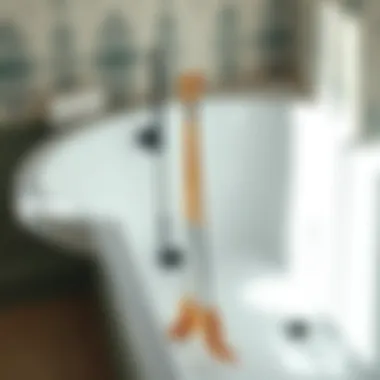
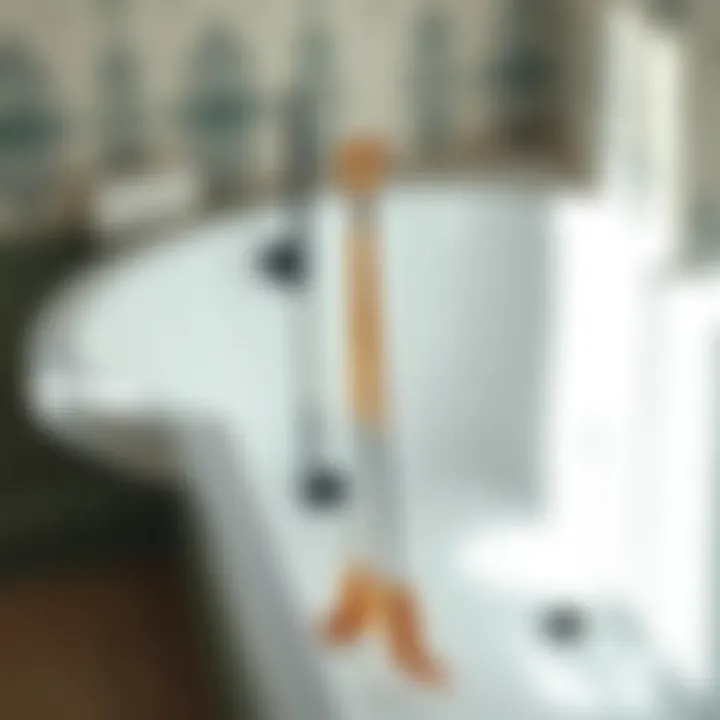
A drain snake, or auger, is another powerful tool in your DIY arsenal. Think of it as your secret weapon against stubborn clogs. Insert the snake into the drain and gently twist it as you push forward. The goal? To either break up the clog or snag whatever's causing the blockage.
- Choose the right type of snake: Manual snakes work for many home projects, but motorized options might be necessary for tough clogs.
- Follow the snake’s lead: If you feel resistance, you may have hit the blockage. Continue to twist and push gently until you feel it give way.
Applying Baking Soda and Vinegar
This method uses a classic combination found in almost every household. Begin by pouring a pot of boiling water down the drain to loosen any debris. Then, add about half a cup of baking soda followed by a cup of vinegar. The fizzy reaction helps to dislodge grease and grime. Let it bubble away for about 15 minutes, then flush with boiling water again to clear out any remaining residue.
Benefits of this method:
- Eco-friendly: No harsh chemicals involved.
- Cost-effective: Simple ingredients make it easy on the wallet.
- Safe to use: Unlike some chemical cleaners, it won’t harm your pipes or the environment.
Hot Water Flush
If you’re dealing with a sink that seems sluggish, a hot water flush might just do the trick. Boil a large pot of water, then carefully pour it directly down the drain. The heat helps dissolve any soap scum or grease build-up, which could be the culprit in your clogging woes.
- Do this regularly: A monthly hot water flush can help prevent slow drains.
- Use gradually: Pour the water slowly to avoid a sudden negation that might cause your pipes to crack.
Using these DIY techniques not only empowers homeowners but saves time and hassle by addressing clogs swiftly. When you know your way around these tools and method, it’s easier to maintain a clean and efficient bathroom. Each approach has its own flair, so try a few out and see what works best for you!
Preventative Measures to Avoid Clogs
Preventing clogs in bathroom tubs and sinks should be high on the priority list for every homeowner. Prevention not only saves time but also reduces the risk of incurring heavy repair costs later. It's easier to maintain a routine than to deal with the aftermath of a clogged drain. Simple habits and sensible choices can keep your plumbing running smoothly, ensuring your bathroom remains a comfortable and functional space.
Regular Cleaning Routines
One of the most effective ways to avoid clogs is establishing a cleaning routine. It doesn't have to be an arduous task, but consistency is key. Regularly clearing out hair, soap scum, and other debris from your drains can significantly reduce the chance of clogs forming. A thorough monthly clean can be complemented by a quick weekly check.
- Daily Wipe-Downs: After each shower or bath, take a moment to wipe surfaces, especially where water collects. This simple act removes buildup before it has a chance to harden.
- Bi-weekly Deep Cleaning: Use a scrub brush and an eco-friendly cleaner to scrub the insides of the sink and tub drains. This helps to dismantle any slimy buildup before it forms decisive clogs.
Regular cleaning routines also have psychological benefits. Knowing that your drains are in good condition reduces anxiety around plumbing issues, allowing for a more relaxed home environment.
Installing Drain Screens
Drain screens or strainers are small devices that you can effortlessly install over your tub and sink drains. The idea is simple yet profoundly effective—they catch debris such as hair and food particles, preventing them from falling into the pipes.
"Prevention is better than cure."
- Cost-effective: Drain screens are relatively inexpensive and can save you hefty plumbing bills down the line.
- Easy to Clean: Most screens can be easily lifted out and cleaned, making maintenance a breezy affair.
By using these screens, you are effectively creating a first line of defense against clogs, giving you peace of mind and a more functional plumbing system.
Mindful Product Usage
The types of products we use in our bathrooms play a significant role in clog prevention. Paying attention to the products and the way they are used can make a marked difference in maintaining clear drains.
Choosing Suitable Soaps
When selecting soap, seek out those that dissolve quickly and do not leave behind excessive residue. Certain bar soaps, although popular, tend to create more residue, which can lead to clogs over time.
- Key Characteristic: The solubility of the soap matters; opt for liquid soaps that tend to wash away more completely. This is especially useful for those with hairy pets or family members, as less residue means less buildup.
Choosing suitable soaps fosters a smoother washing experience and ensures that your plumbing is kept in prime condition, avoiding buildup and promoting a healthy drain ecosystem.
Avoiding Greasy Residues
Leftover grease from soaps and personal care products can cause havoc in your plumbing. Greasy residues tend to trap hair and other particles, leading to a significant risk of clogs.
- Key Characteristic: Look for products labeled as non-greasy; they tend to leave less residue behind and thereby promote clearer drains.
Avoiding greasy residues not only helps in preventing clogs, but it also contributes to more efficient use of water, leading to a better-functioning household.
Establishing these preventative measures can set a solid foundation for a clog-free bathroom. Incorporating small adjustments in cleaning habits, product usage, and preventative installations can make all the difference in maintaining an inviting and functional bathroom environment.
When to Seek Professional Help
Clogged bathrooms can become a real headache. While many homeowners try to tackle the problem themselves, there comes a time when DIY efforts simply don't cut it. Knowing when to call in the professionals is crucial for avoiding further damage and expediting the resolution of your plumbing woes.
Persistent Clogs
If you find yourself battling the same clog over and over again, it’s likely a sign that it’s time to seek help from a professional plumber. Persistent clogs can often indicate deeper issues within your plumbing system. Trying to repeatedly clear a stubborn blockage can create more problems than it solves.
- Underlying issues: A persistent clog could signal a partial blockage in the pipes that might require specialized tools to remove.
- Time and money: Spending money on DIY solutions adds up. Instead of wasting time on ineffective methods, professional plumbers can pinpoint the issue quickly—saving you time and stress.
- Prevent further damage: Continuing to use your sink or tub despite repeated clogs can lead to damaged pipes or water damage, which could cost a small fortune to fix later on.
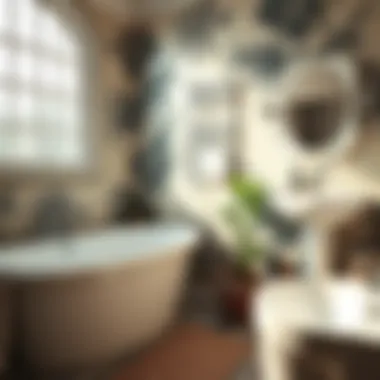
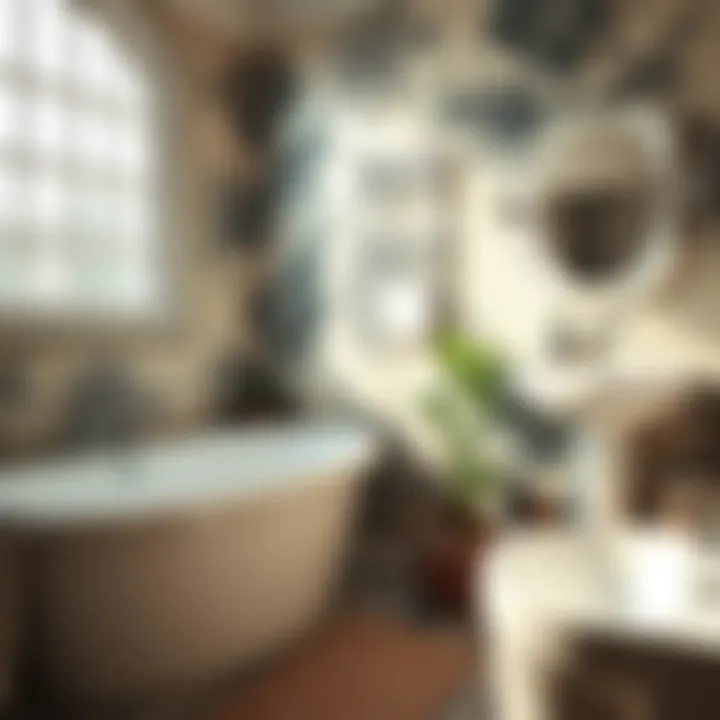
Calling a plumber when faced with persistent issues can also save you from nasty surprises. These professionals have the knowledge and experience to accurately diagnose, properly handle, and effectively fix your drainage problems.
Signs of Pipe Damage
Not all clogs are simple matter of hair balls or soap scum. If you notice symptoms that suggest pipe damage, you should consult a plumber without delay. Here are some signs that you may be dealing with pipe damage:
- Water leakage and stains: Large areas of water on your bathroom floor, or water stains on the walls, may indicate a more serious issue with your plumbing system.
- Unusual sounds: If you hear loud gurgling or banging noises when you drain water, this could signal that your pipes are not functioning as they should. These sounds may arise from trapped air or blockages further down the line.
- Foul odors: A bad smell in your bathroom isn’t just unpleasant; it could indicate sewer line issues that need immediate attention to avoid hazardous situations.
Detecting these signs early can save a significant headache later on.
"Ignoring signs of pipe damage can lead to hefty repairs down the line. Give your plumbing the attention it deserves."
In the end, knowing when to reach out for professional assistance can make all the difference. It’s not just about solving a clog. It’s about preserving the integrity of your whole plumbing system.
Maintaining a Clog-Free Environment
When it comes to the functionality of your bathroom, a clog-free environment is crucial. Not only does it ensure efficient drainage, but it also contributes to a more sanitary and pleasant space. With the hustle and bustle of daily life, the tasks required to maintain this environment can often be overlooked. However, by adopting a few strategic practices, you can dodge the headaches associated with clogged drains.
The primary benefit of maintaining a clog-free environment lies in the prevention of costly repairs and extensive damage. An easily managed drain system not only keeps water flowing but also aids in avoiding unpleasant odors and unsightly backups. Furthermore, a well-maintained bathroom is more inviting for both family members and guests alike.
To cultivate this kind of environment, several considerations should come to mind. Regular attention to your sinks and tubs is essential. It's about building habits that fend off clogs before they become a problem.
"An ounce of prevention is worth a pound of cure."
This age-old adage rings especially true in plumbing.
Establishing a Monthly Maintenance Schedule
Creating a routine for the upkeep of your bathroom's drainage system is a smart step. This schedule doesn’t have to be overwhelming; it is about performing short, simple tasks that keep things flowing smoothly. Consider blocking off some time each month to do a few necessary tasks, such as:
- Clearing out drain covers: Hair and debris can easily collect here. Regular cleaning will keep drains from clogging.
- Flushing drains with hot water: This simple action helps dissolve soap scum and buildup of oils, sending them away before they become troublesome.
- Checking for leaks: A small drip can escalate into a larger issue if not addressed promptly. Keeping an eye out can prevent wasted water and potential damage.
- Using eco-friendly cleaning solutions: Using natural cleaners like vinegar and baking soda occasionally can keep drains refreshed without harsh chemicals.
By establishing a monthly schedule that fits into your lifestyle, you ll contribute to maintaining a clog-free environment without too much hassle.
Educating Household Members
One of the most effective ways to maintain a clog-free environment all starts with education. Everyone in the household should be aware of what can and cannot go down the sink or tub drains. This goes beyond just the household adults; it extends to children as well. Teaching them the significance of proper disposal can save you from recurrent drainage headaches.
Consider holding a family meeting or an informal discussion—whatever suits your family dynamics. You can illustrate:
- The dangers of flushing inappropriate items: Items like wipes, hair, and greasy materials can create significant clogs.
- The importance of using drain screens: These can catch hair and other debris before they go down the trap.
- Best practices: Simple habits like rinsing soap residue down the drain with extra water can make a big difference.
Incorporating this knowledge into the daily routine not only empowers household members but also fosters a sense of collective responsibility. Everybody contributes to a healthier home, while you can enjoy the peace of mind that comes with a clog-free drain.
Understanding Plumbing Systems
Understanding plumbing systems is vital for anyone looking to tackle issues related to bathroom clogs. These systems underpin the entire drainage network in your home, working tirelessly behind the scenes to manage waste and deliver clean water. Having a solid grasp of how these systems function can not only make it easier to troubleshoot problems but also help prevent them in the first place.
How Drainage Works
At its core, drainage in homes operates on a straightforward principle: gravity. When you drain water from a sink or tub, it flows downward through a series of pipes that lead to a larger drainage system, eventually reaching the municipal sewer or a septic tank. This process relies heavily on the slope of the pipes; if they are not sloped correctly, water can pool and create clogs.
Moreover, each component in a drainage system, from the sink's trap to the main sewer line, plays a vital role in keeping things flowing smoothly. Understanding this can help homeowners recognize where problems may arise and how best to address them.
Types of Drainage Systems in Homes
In residential plumbing, there are primarily two types of drainage systems: gravity-fed systems and pressure-assisted systems. Each has its own unique features and considerations that can influence plumbing maintenance and handling clogs.
Gravity-Fed Systems
Gravity-fed systems rely purely on the gravitational pull to move wastewater. This is the traditional setup found in most homes. The key characteristic of a gravity-fed system is its simplicity. Water drains primarily through pipes that angle downward, creating a natural flow.
One significant advantage is that these systems are relatively easy to maintain. Because they don't require complex mechanisms, repairs often involve straightforward pipe cleaning or replacement. However, clogs can frequently occur if the pipes aren't given regular attention. Hair, soap residue, and small objects can accumulate, resulting in a blockage that halts the entire system’s efficacy.
Pressure-Assisted Systems
On the other hand, pressure-assisted systems push wastewater through plumbing with the aid of a pump. This type is less common in standard home settings but can be found in those with unique needs. The key characteristic of this system is its ability to handle higher volumes of water and waste due to forced drainage.
These systems are beneficial in households with low vertical height for drainage, as they can still effectively transport wastewater without relying on gravity alone. However, they can be more expensive to install and maintain, requiring specialized knowledge and skills for repairs. If a pressure pump fails, it often results in immediate and significant drainage issues, necessitating professional help.
Overall, understanding these systems is crucial in addressing plumbing issues effectively. By knowing the type of drainage employed in your home and how it functions, you're better equipped to keep that bathroom tub or sink flowing freely.
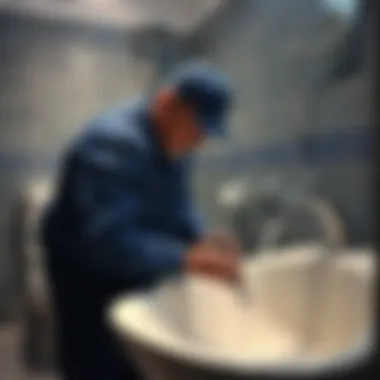
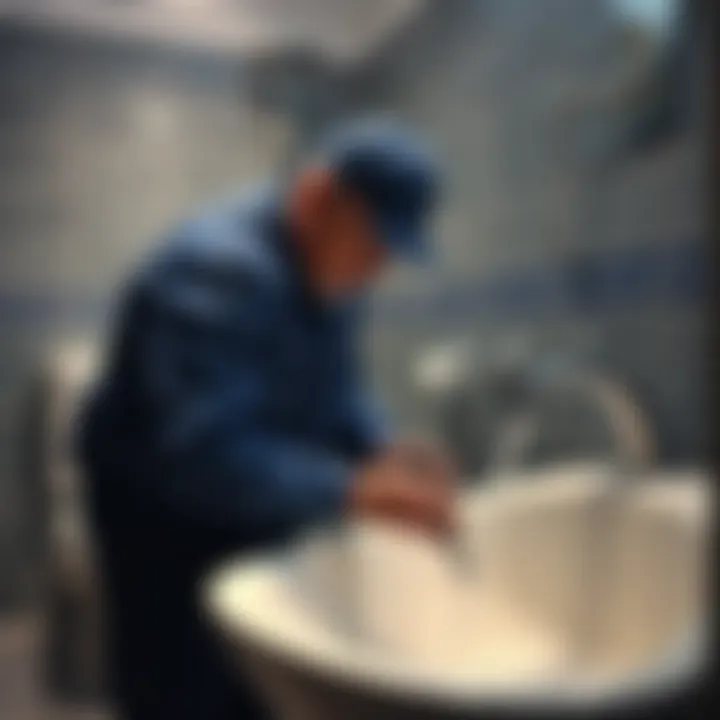
"Regular maintenance and understanding your plumbing systems can save you from unexpected headaches down the line."
For more information on plumbing systems and maintenance, you can refer to resources available on Wikipedia or Britannica.
In summary, knowing about plumbing systems not only enhances your home maintenance skills but also empowers you to make informed decisions when faced with clogging challenges.
The Role of Maintenance Products
When it comes to tackling problems like clogged bathroom tubs and sinks, maintenance products can be your best friend. Not only do they help to prevent clogs from becoming a nasty headache, but they also contribute to the overall health of your plumbing system. In a busy household, the last thing you want is for a small blockage to escalate into a costly issue. Thus, using the right maintenance products is crucial. They can save you both time and money in the long run.
Chemical Drain Cleaners
Chemical drain cleaners have long been a go-to solution for many homeowners facing stubborn blockages. These products generally contain powerful agents like sodium hydroxide or sulfuric acid, designed to break down tough materials such as hair, soap scum, and other debris that can accumulate in your pipes. The appeal of chemical drain cleaners lies in their convenience—often, you simply pour the product down the drain and let it work its magic.
Nonetheless, it’s important to approach these cleaners with caution. They are highly effective but can also pose risks if misused. For instance, pouring too much cleaner can corrode pipes over time, especially if your plumbing system is made of older materials. Additionally, the fumes emitted can be harsh. Always ensure that you ventilate the area adequately and wear gloves to protect your skin from any potential burns.
"While chemical drain cleaners can be a quick fix, it’s wise to balance their use with other preventative measures for a healthy plumbing system."
Enzymatic Cleaners
On the flip side, we have enzymatic cleaners, which have gained popularity for their eco-friendly approach. Unlike their chemical counterparts, enzymatic products use safe microbes and enzymes to break down organic material. They are particularly effective at degrading food particles, grease, and hair without the risk of damaging your plumbing.
The beauty of enzymatic cleaners is that they work continuously. After application, they remain active in the pipes, breaking down organic matter that might have slipped through your regular cleaning routine. This makes them great for preventative maintenance. However, it is essential to remember that while these products are safer for your plumbing and the environment, they may not be as quick to act as chemical drain cleaners.
In summary, deciding between chemical and enzymatic cleaners often comes down to your specific situation. If you’re facing an immediate blockage, chemical cleaners may provide a fast response. However, for ongoing maintenance, integrating enzymatic cleaners into your routine can keep your pipes clear and functioning efficiently.
Cost Implications of Clogged Drains
When it comes to maintaining your home, few things are as frustrating—and potentially costly—as clogged drains. Bathroom tubs and sinks can easily fall victim to blockages due to a variety of reasons, from hair accumulation to the remnants of soap scum. In this section, we'll discuss the financial impacts associated with clogged drains, offering insights and considerations that can help homeowners and housewives effectively manage this common household nuisance.
Financial Impact of DIY Solutions
Tackling a drain clog on your own can be tempting, especially when you think about saving those hard-earned dollars. With a bit of know-how and the right tools, many individuals find they can handle minor clogs without bringing in a professional. However, it's crucial to consider both the immediate and long-term financial ramifications of DIY solutions.
- Initial Costs: The upfront costs for common DIY tools, such as a plunger or a drain snake, are relatively low. You can purchase a decent plunger for as little as $10, while a quality drain snake might set you back around $15 to $30.
- Potential for Damage: If you're not careful, DIY efforts can sometimes result in more harm than good. Utilizing chemical drain cleaners or mishandling a drain snake could damage plumbing. Such damage can lead to higher repair costs down the road.
- Time Investment: Time is money. Spending hours trying to fix a stubborn clog might not always be worth it, especially if your trial-and-error method takes longer than hiring a professional.
- Recurrent Issues: Even after success, there’s no guarantee that you'll solve the underlying problem. If the core issue persists, you might find yourself in the same predicament weeks or months later, further compounding costs.
Ultimately, while DIY solutions can be effective for minor clogs, it's a gamble. The financial implications may sometimes outweigh the benefits, so homeowners must weigh their options carefully.
Professional Service Costs
When DIY methods fail or when a major clog rears its ugly head, most homeowners eventually face the reality of calling in the professionals. Here’s what you can expect regarding costs when seeking professional assistance for clogged drains:
- Service Charges: Most plumbers have a standard service fee that usually ranges from $50 to $150, depending on the time of day and the level of urgency. After-hours call-outs will typically have a higher fee.
- Diagnostic Fees: Sometimes it’s not enough to just clear the clog. A thorough inspection of plumbing will ensure that no underlying issues—such as tree root infiltration or significant pipe degradation—are present. This diagnostic process may incur additional costs.
- Cost of Repairs: In a worst-case scenario, the plumber may discover that part of your plumbing system requires repair or replacement. The average cost for pipe repair can reach into the thousands, depending on the extent and location of the damage.
- Value of Expertise: Think of it this way: hiring a professional means you're getting an expert with years of experience, specialized tools, and a guarantee of their work. While the upfront payments can seem high, the long-term prevention of further issues can provide substantial savings.
Ultimately, while it may be tempting to solve clogged drains on your own, understanding the potential costs involved in both DIY and professional assistance is key to making informed decisions. Being proactive can save both time and money, leading to a more pleasant and functioning bathroom.
Taking care of the health of your plumbing is an investment that pays dividends; prevention and timely intervention can stop small issues from snowballing into larger, more costly repairs.
For more on home maintenance tips and financial advice regarding home repairs, consider checking out various resources such as Wikipedia, Britannica, or community discussions on Reddit.
The Environmental Considerations
Addressing clogged bathroom tubs and sinks goes beyond personal inconvenience; it touches on a larger, often overlooked issue that affects our environment. The way we manage our plumbing dilemmas can have significant repercussions on ecosystems and water conservation efforts. Every step we take in handling clogged drains influences not only our immediate living conditions but also the health of our shared planet.
One of the fundamental aspects to consider is the type of cleaning products we use. Many common chemical drain cleaners contain harsh substances that can severely harm aquatic life if they enter waterways. Additionally, these chemicals can leach into the ground, adversely affecting soil and plant life. By opting for eco-friendly alternatives, we not only ensure a healthier home environment but also contribute to the protection of our natural surroundings.
Furthermore, frequent clogs can lead to a more considerable waste of water. A blockage means that water isn't draining as it should, leading to water pooling and additional usage to flush the system out. This unnecessary consumption diminishes our water resources, especially in areas where water is already a scarce commodity.
Being mindful of the sanitation methods we choose and being aware of how clogs impact our environmental footprint encourages a more holistic approach to home maintenance. Ignoring these considerations might seem trivial, but collective negligence can lead to considerable environmental strain over time. Let's take a closer look at how our cleaning choices can alter the course of water conservation practices.
Eco-Friendly Cleaning Options
There are several effective, eco-friendly solutions to deal with clogs without resorting to harmful chemicals. Here are some methods that can do the trick:
- Baking Soda and Vinegar: A classic combination, pouring them down the drain creates a fizzy reaction that can dislodge debris.
- Salt and Hot Water: A mix of salt and boiling water can break down grease buildup. Just pour it down and flush with more hot water.
- Essential Oils: Not only can they neutralize odors, but a few drops of peppermint or tea tree oil may also have antimicrobial properties to prevent future clogs.
"Opting for natural alternatives doesn't just clear your pipes; it clears your conscience, knowing you're being gentler on the planet."
By using these natural substances, housewives and homeowners alike can effectively clear clogs while minimizing their ecological footprint. It's a win-win for both household maintenance and environmental stewardship.
Impact of Blockages on Water Usage
Every time a sink or tub is clogged, the water that doesn't drain properly gets wasted. Homes may experience significant water loss, leading not only to increased bills but also substantial waste. According to the EPA, household leaks can waste nearly one trillion gallons of water annually in the United States. Just think about it—in a household with persistent clogs, this wasted water is not just a number; it reflects both financial and environmental consequences.
The repercussions of this excess water usage extend beyond individual bills. As we consume more water due to blockages, the demand on municipal water supplies escalates. In areas severely impacted by drought or water scarcity, this added burden exacerbates existing challenges. Additionally, it may worsen the treatment plant’s workload, which can lead to more untreated wastewater being released into the environment.
To put it plainly, we all have a part to play in conserving this essential resource. Being proactive about maintaining clear drains is a direct action every homeowner can take to support water conservation efforts. It reduces both utility costs and environmental strain, paving the way for more sustainable habits in our households.
By making intentional choices, not only can we unclog our drains effectively, but we can also prioritize the health of our planet and promote responsible water use.



